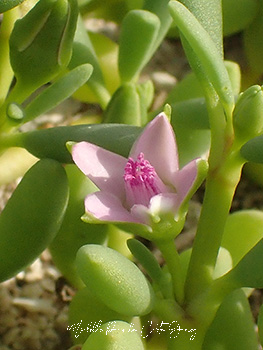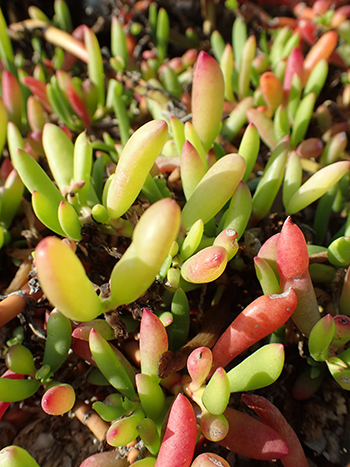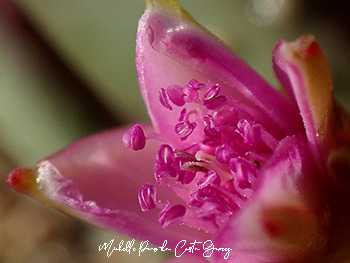This post is also available in: Dutch (below)

Along the entire northern coast of our island, in the saliñas and along inlets and inner bays, grows a small plant that we all walk over carelessly and hardly look at. This succulent with elongated rounded leaves varies in colour from light to dark green to red orange, with lovely small pink flowers. This plant is known as Banana di ref in Papiamentu (sea banana), probably because the leaves have a bit of a banana shape. In certain places, the plants can take up large fields and give the rugged coastal plain an unexpected green glow. Scientifically, the plant is known as Sesuvium portulacastrum and in English the plant is called the Sea purslane.
This plant is edible, and is even very easy to propagate and grow yourself as a food plant, since it grows well in pots and requires little attention. The unfamiliarity with its edibility is by far the biggest reason that this plant, which grows so easily on our island, is so rarely central to the vegetable gardens or our kitchens. If eaten from the wild however bear in mind that not all locations are healthy to consume from. If the plant grows downstream from sewage leakages or deliberate sewage dumping, in the vicinity of oil and chemical pollution (for example due to the burning of copper wires), and garbage, it will be unsafe to consume!

The leaves of the Banana di ref have a fresh, sometimes slightly salty taste, due to the fact that the plant grows in coastal zones and stores the salt from salt spray, which is blown onto the land by the wind, in the leaves. They can be eaten raw in salads, where they pop like grapes when eaten, but can also be processed into pestos and added to stir-fries. The leaves can also be boiled. In addition, the thick, swollen leaves are preserved like pickles on some islands.
If you want to grow the plant in the garden, it is good to do this in a sunny spot and in a sandy substrate. The plants can withstand bright and direct sunlight very well. You can even mix soil with sea sand for a good mix. Because the plant can withstand salt well, it can also be grown in places where the groundwater is saline and only brackish water comes from the well. The plant also needs little to no fertilizer and watering is also hardly necessary. Once a week or even every 2 weeks is sufficient. Cutting the plant is relatively simple. If you find a sturdy plant with thick leaves along the coast, you can carefully follow the branches until you find a small tendril with starting roots. Carefully cut it off here and plant the cutting in a pot. You can of course also look for the seeds of the plant.

The sea purslane blooms almost all year round with pink flowers that attract many bees and also small butterflies such as the Hanno blue. Search the tendrils for the seed pods and sow these in a pot. This is of course a bit slower than cutting the plant. If you choose to use cuttings, be responsible with the mother plant and do not just pull it out of the ground.
English name: Seashore purslane/ Sea purslane
Papiamentu/Papiamento name: Banana di rif / Salachi (cora) (Aruba), Banana di ref (Bonaire +Curaçao), Bembe di ref (Bonaire)
Scientific name: Sesuvium portulacastrum
Family: Aizoaceae (fig-marigold family)
Occurrence (ABC islands): Aruba, Bonaire and Curaçao

Wilde Bloemen – Banana di ref

Langs de hele noordkust van ons eiland, in de salina’s en langs binnenwateren groeit een klein plantje waar we met z’n allen achteloos overheen lopen en nauwelijks naar kijken. Dit vetplantje met langwerpige afgeronde bladeren varieert in kleur van licht tot donkergroen tot rood oranje, met lieflijke kleine roze bloemen. In de volksmond staat dit plantje bekend als Banana di ref, omdat de blaadjes een beetje een bananenvorm hebben waarschijnlijk. Op bepaalde plekken kunnen de planten grote velden innemen en geven de ruige kustvlakte daarmee een onverwachte groene gloed. Wetenschappelijk staat het plantje bekend als Sesuvium portulacastrum en in het Nederlands wordt het plantje de Zeepostelein genoemd.
Deze plant is eetbaar, en is zelfs heel makkelijk te stekken en zelf op te kweken als een voedingsplant aangezien het goed groeit in potten en maar een geringe hoeveelheid aandacht nodig heeft. Het onbekend zijn met de eetbaarheid ervan is verreweg de grootste reden dat deze, op ons eiland, zo makkelijk groeiende plant, zo weinig centraal staat in de moestuintjes of onze keukens.

De blaadjes van de Banana di ref hebben een frisse, soms wat zoutige smaak, omdat de plant in kustzone’s het zout uit de saltspray, dat door de wind het land op wordt gewaaid, in de bladeren opslaat. Ze kunnen rauw gegeten worden in salades, waar ze als druiven knappen in de mond bij het eten ervan, maar kunnen ook verwerkt worden tot pesto’s en in de roerbak worden toegevoegd. Koken van de bladeren kan ook. Daarnaast worden de dikke opgezette blaadjes als augurken ingemaakt.
Wil je de plant in de tuin kweken dan is het goed dit te doen op een zonnige plek, de plantjes kunnen heel goed tegen fel en direct zonlicht, in een zanderige ondergrond. Je kunt zelfs aarde met zeezand mengen voor een goede mix. Omdat de plant goed tegen zout kan, kan deze ook gekweekt worden op plekken waar het grondwater verzilt is en er alleen brak water uit de put komt. De plant heeft verder weinig mest nodig en water geven is ook nauwelijks nodig. 1 keer in de week of zelfs de 2 weken is voldoende.
Het stekken van de plant is relatief simpel. Vind je een stevige plant met dikke bladeren langs de kust dan kun je de vertakkingen voorzichtig volgen tot je een kleine rank vindt met beginnende wortels. Knip dat hier voorzichtig af en plant de stek in een pot. Je kunt natuurlijk ook op zoek gaan naar het zaad van de plant.

De sea purslane bloeit bijna het hele jaar door met roze bloemen die veel bijen aantrekken en ook kleine vlinders zoals de Hanno blue. Zoek de ranken af naar de zaaddoosjes en zaai deze in een pot. Die gaat natuurlijk wel iets langzamer dan het stekken van de plant. Mocht je voor stekken kiezen, ga dan verantwoordelijk om met de moederplant en ruk deze niet zo maar uit de grond.
Nederlandse naam: Zeepostelein
Papiamentse naam: Banana di rif / Salachi (cora) (Aruba), Banana di ref (Bonaire +Curaçao), Bembe di ref (Bonaire)
Wetenschappelijke naam: Sesuvium portulacastrum
Familie: Aizoaceae (ijskruidfamilie)
Voorkomen (ABC eilanden): Aruba, Bonaire en Curaçao